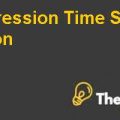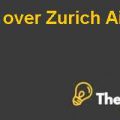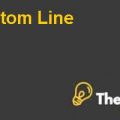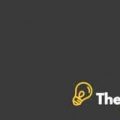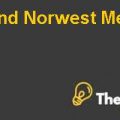7-Eleven Japan Case Study Solution
Factors Allowing the 7/11 to operate at almost 1 inventory turn in a week for convenience store business, and the similarities in the supply chain between ZARA and 7 Eleven Japan.
The main factors for Seven Eleven Japan (SEJ) to provide almost 1 week of inventory turnover at its convenience stores are provided below:
Freshness Job Strategy:
The executed strategy of SEJ to provide the fresh products displayed at the stores; not only the perishables but other items are also replenished with fresh products and the items offered in the shops are considerably fresher than other convenience stores. This is provided by tracking customer preferences and their changing behavior towards the products, and non-fresh products being destroyed; for example; coffee having a life of not more than 2 hours.
Information systems and the use of OFC’s:
The information system implemented by the 7/11 is very up to date, with two way communication between the store and the HQ, manufacturers, and other areas. Further, beside the store manager; the organization’s operation field counselors (OFC’s) has direct contact and influence which consider the customer preferences of the convenience store. The stock is ordered in small quantities throughout the week, making the store to turn out inventory as soon as possible.
Daily Ordering System and the Supply Chain:
This factor is the main backbone of the organization, with the information system having direct contact with manufacturers about items to be delivered and their specific quantity. There is a daily ordering system in which the corporate manager orders products which are delivered daily, with the manufacturers being on board through the contact with the HQ. This results in low quantities being provided according to the needs daily, making the inventory move out.
Main Similarities of Supply Chain between ZARA and the SEJ
Small Batch Productions:
Zara considering SEJ has also a very low inventory turnover, they create smaller quantities to assess the demand and the success of its sales. This is similar to the SEJ as they also order quantities which are low and according to the demand. This makes the inventory turnover rate considerable less for both organizations.
Central Distribution Center:
Like SEJ, ZARA has a strong IT system backing its distribution. All clothes produced are shipped to Spain, and then distributed. SEJ also has a similar model, which implies not having different distributors for every product, and using the Supplier Distribution Center (SDC) for the distribution to the stores.
Quick Response to the Demand:
Another similarity is the variable quantities being supplied, as required by the needs of the current times. ZARA also has this chain in line with 1000 new designs being made every month, looking at customer requirements and then ordering as per need.
Three key features of 7-Dream.com’s e-business, the risks and rewards of the e-business model, bottlenecks, weaknesses, and suggestions for improvement for the Seven Eleven Japan.
Three key features of the 7-Dream.com’s e-business are provided below:
- New Company with renowned partners of the Japanese Market; NRI, SONY, MITSUI, JTB, and KINOTROPE. Providing many products for the consumers at one stop, ranging from Convenience goods to travel network.
- Online business Company, with no physical shop and distributed through partners personal supply chains.
- Items collected from different venues, as requested by the Customer on his convenience in 2-3 days.
The risk and rewards of this business model:
Risks:
The organization is new with no previous or past coordinated work experience, which might create management issues for all the organizations in this venture. Further, the organization which will fail to be successful will tarnish the image of all partners, even though with one glitch from any partner involved. The online store will only provide the consumers with dissatisfaction as no physical appearance or showroom is available, the trusting part of the Japanese consumer takes time. The orders might have problems if a consumer wants items of more than 1 partner, what will be the destination to collect up; who is going to complete the order.
Rewards:
Very low costs in comparison to their competing online sales companies. Range of items being available to shop from, increasing the customer inflow to the 7-Dream Website.
The delivery system is very high, as not much inconvenience will be provided to all the companies, as distributions can be maintained at their own leisure.
Some of the partners are competing in different environments, this will create a problem on the intellectual property and strategies being taken by the other organizations.
Bottlenecks:
Combined offers cannot be provided, as all the companies are different. Consumer will feel a sense of one company, which might create awareness problems for separate entities of the partners.
Combined focus in place, rather than separate entity perception.
Suggestions for improvement:
Using an SDC as the SEJ is implemented in its own convenience stores for the distribution which will unify the products from all partners, and provide problems for delivery. Though this will add costs for the 7-Dream organization.
Q.8 Seven Eleven US Model; introduction of the CDC’s and its pros and cons, and pros and cons for having a distributor replenishing stock to the 7/11 inbound distribution.
The duplication model, being put in place by the SEJ in the US market has certain pros and cons attached, which are as follows:
Pros of CDC:
The pros relate to the success of Seven Eleven in Japan, the company used the SDC program to support the sales and the distribution channels. As this model has been in place from the 1990’s in the Japanese industry, the Seven Eleven has high experience of this model which will create an ease in its use in the new market.
Another pro for using this system is to manage the items in the convenience stores, using different manufacturers and retailers to provide for the replenishing stock provided with the usage of different trucks being in and out with protocols to follow. The CDC system will ensure that stock provided will be up to the quantity required with less hassle as possible. The SEJ’s SDC in Japan has a truck time per store of not more than 1.5 Minutes to supply all items.
Cons of CDC:
The cons of using the SDC is that the motto of Seven Eleven to provide for the fresh food might not uphold due to the first manufacturers providing the foods and items at the CDC and then shipping to the stores, which will take time till stock being kept on the shelf. Another con is the added costs which will be attached to the CDC as the transportation will add to the tight revenue margins of the organization.
The next part of the Pros and cons will relate to the Distributor replenishing stock rather than the Distribution of the Management of Seven Eleven.
PROS and CONS:
The pros for the distributor replenishing stock is the time savings and more quantities with fixed schedules which will help the store managers to create a schedule upon their ease of the replenishment of the stock.
The con for using the distributor is that, the POS and GOT implemented by SEJ of minimum quantities as required basis will not be effected as the distributor will just be the supplier and this might lead to some items being overstocked and others being under stocked.
Q.9 the differences between Seven Eleven Japan and Inditex (ZARA) strategies; defining the return on assets, commenting on the decentralized versus vertical integration.
Differences in Strategies:
- Timing and the freshness of the product:
This strategy looks similar to both organizations as low stock and customized quantities, but the supply of both the products use different strategies as 7/11 has perishables which are of daily occurrences rather than the monthly stock strategy by ZARA.
- The IN HOUSE Distribution strategy:
As provided in the above questions, all the manufacturing of ZARA has to be supplied to SPAIN and then distributed in other areas. This is different to the 7/11 as the products of the convenience stores are mostly general in nature with no in-house refinery or plant. It cannot be applied to 7/11 organizations due to the nature of the business.
- Different Product Development Teams:
ZARA has different product development teams working separately, however SEJ has made use of the OFC’s and area managers which are required to fly to the HQ every week for evaluation and new instructions. They have to work together to improve and to assist the overall organization, which is entirely different in ZARA with separate teams working in isolation to others.
- Vertical Integration (VI) and Decentralization strategy:
Zara uses the VI model of acquiring its manufacturers and the retailers creating one seamless flow of activities, on the other hand SEJ uses decentralization with different CDC’s and store managers and OFCs responsible for their own units.
This creates differences in the strategies, but due to the different nature of businesses; they are both successful and centralized strategy will not be sufficient for 7/11.
The Return on Assets formula is Net income divided by the Total Assets. In consideration to the Seven Eleven Japan and the Inditex (Zara), the ROA of SEJ must be lower than the INDITEX. The reason is because of the nature of business. ZARA works in apparel industry with higher margins as compared to SEJ which works in the convenience market with lower margins on the products being sold, making the ROA lower as more resources are used in the generation of income for SEJ.
Q.10 Critical Assets of 7/11 Japan, Inditex (ZARA), and the role of product innovation for both organizations.
Critical Assets of 7/11 Japan:
- Information system, with double loop connecting the Head Quarters of SEJ with Stores, SDC, Manufacturers, and retailers with 2-way communication.
- An Operational design supporting the quick and responsiveness of different convenience stores throughout Japan and neighboring areas.
- Logistics and Delivery Channels.
- A Brand Name.
Critical Assets of Inditex (ZARA):
- Vertical Integration Model creating a Seamless flow.
- Intellectual property: BRAND NAME
- Logistics and Delivery Channels.
We will be considering the Role of product innovation for both the Businesses.
SEJ:
When we consider the product innovation for the SEJ’s current business model and the critical assets. The product innovation will not affect the model or the chain as the products are provided through the Manufacturers to SDC and then they are provided to the retail stores.
The only effect, which can occur is the time period of the available product which might change. The organization has already other perishable products such as coffee which has 2 hour shelf life, SEJ will not change and can provide for the new product with ease.
ZARA:
The product innovation at ZARA will be directed because of the changes in the consumers’ tastes, and that can be a negative impact on the organizational model as the whole system is one flow. The HQ is based in Spain with all the powers. The organization will be affected as the current model will need to be re-thought to best assist the organizational needs and profitability...............
This is just a sample partical work. Please place the order on the website to get your own originally done case solution.


